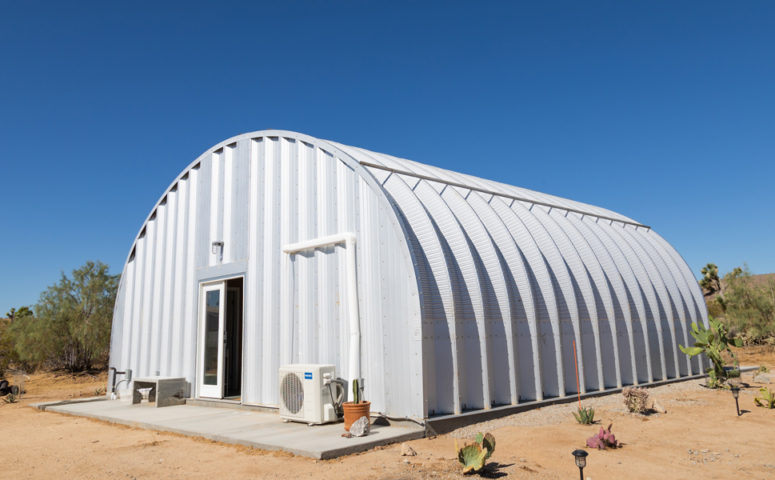Leaving Barstow, the road drops and the great vast Mojave desert comes into clear view. The huge emptiness is both frightening and strangely familiar. On the one hand, it’s hard to imagine living in such a harsh environment, and yet it feels like any idea might emerge from here. As we approach Yucca Valley, modest houses dot the landscape. Less dense than suburbia and unmanicured, the place feels unfinished. Navigating a grid of dirt roads, we see a shiny new Quonset hut in the distance. The Yucca Valley Material Lab, also known as Lazy Eye Ranch. Underneath the new pergola, I sit down with artist Heidi Schwegler to talk about her work, her move from Portland, Oregon, to the desert, and her vision for the Yucca Valley Material Lab.
Q: I am interested in picking up where the catalog of your work leaves off. Tell me why you chose this place and what your vision is.
A: I moved to Portland right after grad school and taught at the Oregon College of Art and Craft for nearly 20 years.
I started as the studio manager and over time made it to full professor and chair of a graduate program. I was committed to that college but was starting to feel a little disillusioned by higher education. As chair, I was responsible for all of the recruitment for the grad program and had to convince prospective students to invest a lot to become a “creative entrepreneur.” I hate to admit it, but I was beginning to feel like a car salesman. And frankly, I’d been in the Pacific Northwest too long.
My partner, Derek, and I had been together a year. I knew he was losing interest in Portland. He grew up in the desert and missed it. My studio practice had become somewhat peripatetic because I had been attending residencies all over the world. Being away from the comforts of my studio and my tools, I began to feel confident I could make work anywhere.
Wandering and gathering found objects to inspire new work, meeting new people and being in very alien sorts of landscapes—at least alien to me—was where my practice existed. So I knew if I left Portland and went someplace very different, I would no doubt feel inspired. I was tired of having the right answer for everything. I wanted to start over. I wanted to feel young and ignorant again, not knowing what that actually felt like, which in the end was very very hard.
In 2018, I went to a conference in Los Angeles. I had traveled there a lot in the past, in fact did a two-month residency at 18th St Arts Center. I had also taken students to Andrea Zittel’s compound in Joshua Tree several times. So I had experienced the area, but I didn’t really know it. Derek met me in Los Angeles after the conference was over, and we came out to Joshua Tree for one night. Two friends of ours had recently bought a house in Yucca Valley, only a mile from where we are now. So we drove by it to check it out from the road—they hadn’t moved in yet.
Driving down the dirt roads and passing all of the Joshua trees, I thought, “This is the weirdest landscape. This is so cool. So completely different from Portland.” After seeing our friends’ house, we drove straight to the bar, and I got out my iPad and wrote down every house that was on the market. Within an hour, we had stopped at the first house, found a realtor, and put in an offer. We had no idea this was going to happen. Sometimes Derek lets me make these crazy, impulsive decisions.
And as we drove to the hotel, which was a 30-minute drive, I turned into this raging bitch because I was obsessively trying to problem-solve how this was all going to work, how we would make money and survive. I’d need to quit my career, sell our house, leave our friends, change our lives. So I’m in the car panicking, trying to figure the whole thing out in 30 minutes. Which of course was impossible. We get back to the hotel, and he’s like, “Oh, look. There’s a liquor store. I’m going to go get a six-pack.”
In the morning, he wakes up and says, “You know, Heidi, we’re only two and a half hours from Los Angeles. You could meet people there. Maybe you could even have a little studio there.” I screamed, “That’s what I’m talking about, Derek! You have to help me figure this thing out!” So he’s a little bit slower in reaction, more methodical, and always right.
We didn’t get that first house, but a few days later, this place came on the market. I saw it online while we were back in Portland. I said, “Well, there’s a lot of crap on the property. But, look. It’s a cinderblock midcentury ranch. It’s two acres. It has huge Joshua trees. The price is right. I don’t know what the mesa is. I don’t know anything about the location. But let’s not overthink it.” We made an offer within an hour of it going live. Completely virtual.
The realtor made us go through the next steps in person. Derek flew down first and returned that same night. When he got back, he rubbed his chin and said, “Well, I think we just need to clean it.” Then I came down three days later and almost threw up. I knew exactly the scope of the project. You would walk around the property and get lost, there was so much crap. But we committed to it. We moved down here maybe four or five months later. Before that, though, to at least make it livable, I would fly down on the weekends and rip out flooring and carpeting and poorly made built-ins. I took care of some of the really nasty stuff. Derek got a job in July, and he had to move here. He slept in a gutted room on an air mattress, and I moved all our stuff and two cats a month later. Ironically, a year later, Oregon College of Art and Craft closed. I would have lost my job regardless.
I strongly believe in art education and giving people an opportunity to explore material directly. People need to know how to make things and how to use their hands in order to express themselves. So that’s what I decided to do here: build an artist residency and workshop program that is affordable and open to all.
We’re in the right place. But in the beginning I didn’t really know that, and I certainly didn’t know how to start a program, I’m definitely learning on the job. I trusted the force of what was happening, and we took every dime from my Portland house sale to build a Quonset. I just jumped in. It’s taken on a life of its own now, almost apart from me.
Living here has also really inspired my studio practice. It’s brutal. It’s beautiful. Every plant will stab you: I was shivved by a yucca plant in my first week and almost scalped by a low-hanging Joshua tree. I’ve seen a lot of animals try to survive yet die. Most of my work in Portland was about my absolute fear of my own mortality, so I guess it all fits right in.
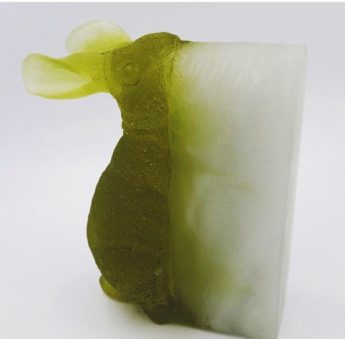
Zoonosis, glass, 2019
Q: How does somebody with your vision not stop the car every few miles to check out the various kinds of found objects or beings? How do you stop seeing long enough to get anything done?
A: Well, you know, there are three things that have to be inherent in the found object. I don’t like all trash. The first thing is their original function, what they used to do. Like a pillow, it’s the most intimate object in our home. That intimacy makes me think of my body. The second is the damage the object has endured. Was it hit by a semi? Crushed by a moving car? Thrown out of a window? The third detail that’s important is its new context, like when you see a ladder off to the side of the highway. Those are incredible because they look so fragile. You see them in a place where you would never expect to see a ladder. And its twisted position in space also matters. It’s as if you get to see a ladder again for the first time. If all three of these things work together—function, damage, and context—it instantly reminds me of my body and my own mortality. It’s like a transference of that object into my body and my body into that object. People familiar with me and my work send me pictures of trash all the time, but it doesn’t always work. Thank God. Because otherwise I would just spend all of my time cleaning the streets of trash.
Q: How perfect that you should buy a home with a lot full of trash.
A: I know. What’s so ironic is that I had it all hauled away as soon as I could. I was so overwhelmed. It was too much. I couldn’t even see it.
Q: So you didn’t keep anything?
A: No, not a thing. And I regret it. But I cannot express to you how much was here. There was so much layering that visually separating each one in order to consider its new context in this landscape was impossible.
Q: Please show me around.
A: Our property, which is just under two acres, goes all the way out to the street, which is just on the other side of that yucca plant. After looking for about a month, I found this 1977 Wilderness camper on Craigslist. I knew I needed at least one so that the artists wouldn’t be living in our home, a detail not negotiable with Derek. This one was only $300, a steal. I invited a few Portland graduate students to come down, and they had a design-build workshop. We gutted it, and they designed the interior and started the transformation.
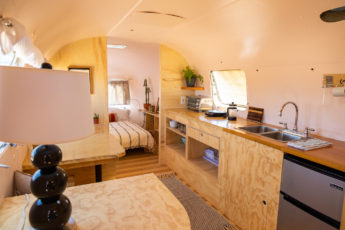
The Condo, 1971 Airstream
The graduate program where I was chair was in a huge warehouse. And none of the rooms had walls that went to the ceiling, but they needed an enclosed space for the computer lab. The previous chair found this Airstream on somebody’s farm, and it became the computer lab. When the program closed, the college was willing to sell it to me. It didn’t cost much, but getting it down here was another issue.
At the beginning of the pandemic, the graduate student who led the design-build of the Wilderness came back down here. He completely customized the Airstream based on someone else’s design. I’ve named it the Condo because it’s so nice, and because the designer’s studio is called Nice Condo. The third camper, a 2001 Nomad, was recently donated to the program by a friend of mine in Portland. It’s the newest of the three, and it’s ready to go. I didn’t have to do anything to it. To create a sort of internal courtyard between the campers, the program’s first intern designed the concrete hardscape, before all these campers were even here. She and I started the casting together, and I ended up finishing it shortly after she left.
The concrete cubes weigh about 3,000 pounds in total and are used as seating, pedestals, and planters. I recently spread 10 tons of gravel, which has pulled it all together.
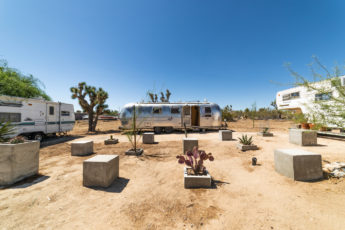
Artist in Residence Lodging, cast concrete hardscape
Q: Right. It feels very Donald Judd-esque.
A: Isn’t it? The designer, Nice Condo, even has a secondary project called Jonald Dudd.
We built the Quonset hut last January. The grad student who finished the Airstream led a team of four local workers, and they figured out how to do it together. It only took them a week and a half to get the structure up. This is where we teach all of the workshops, and it’s where the artists in residence work. During the pandemic, I had time, so I learned how to build the work tables. There’s been a lot of building on this compound since March.
When we teach the classes, we will require masks, and we’re going to keep the garage door open so that there’s a lot of cross-ventilation. I also do some of my work in here, but now that all the artists are moving back in, I’m going to go back to my studio. Each artist gets two tables, basically half of the Quonset. They’re here anywhere from two to three weeks, and most of them focus on glass, though that’s not required. There’s also metal casting, ceramics, welding, and woodworking equipment. It’s an instructional residency, so the premise is to learn a new skill, to explore a new material; we teach them. I just built this centrifugal casting unit, so now I can also teach lost wax casting in metal.
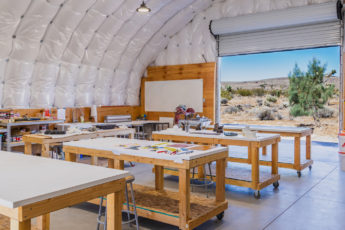
Yucca Valley Material Lab Interior
Somebody donated a foundry, and as soon as it’s set up, we will be able to teach aluminum and bronze medium-scale casting. Another person donated the ceramic kiln and slab roller. It’s happening. People are learning about us and supporting us by taking classes or donating equipment. This type of space is very much needed out here, so many are coming to help out in any way they can.
Q: For the classes, where are the students coming from?
A: Most are from our local community, and others come from Palm Springs. Los Angeles is starting to find out about us too. Now that I have campers, artists from out of town are traveling here because they can stay on the property and take a workshop. Some of the classes are as long as five days.
Outside the Quonset garage door is where all the glass cold working happens. When you cut and grind glass, you have to use water, so it’s best to be outside because it’s so messy. As soon as I can find another $2,000, I’m going to have this area covered, because it gets brutally hot out here in the summer.
Let me show you the sculpture garden area, which is the newest project.
It took me a while, but with all of the transformation on the property the past two years, I now consider the two acres to be a sort of sculpture in and of itself. And recently I began installing some of my older work outside. Which in turn has inspired new work. So that’s what I’m focused on in terms of my personal studio practice right now. Making site-specific work.
Artists in residence in the past would sometimes leave a little bit of water in a five-gallon bucket outside overnight. Sounds like it’s not a big deal, but I quickly learned that squirrels will crawl in for the water and end up drowning because they can’t get out. It was horrifying and very upsetting to me. Rather than just torture myself with guilt, I made new work about it. I’ve been sculpting abstracted squirrel forms and casting them in glass. The final pieces are not directly from the actual bodies of the squirrels, though—everyone seems to ask this. I started with resin garden sculptures. I made molds and then resculpted the forms once they were in wax. I had no interest in making a mold of a wet rotting squirrel.
I’ve also been feeding the bunnies on our property. I like to look at them up close with binoculars so I can really see them. They’re pretty funny. The ones that are completely intact look like each other, but the ones that are missing part of an ear or have a weird nodule growing on their face have become the one-of-a-kind bunnies that I can now recognize. One bunny had a perfect circle in its ear, like it was made with a hole punch. It’s kind of related to my work because it’s similar to my attraction to the discarded object—initially made to look just like all the others, but now that it’s damaged and tossed, it becomes one of a kind to me.
This piece is actually a plaster casting from an area in my basement in Portland. It’s called 3AM. Normally I would have objects placed on its surface—a piece of chewed gum cast in glass, a silk mayonnaise packet, and gold-plated cast bronze chicken bones. But the windy season is coming up, so it’s just the empty plaster form. When I was a young kid, I remember sitting in the front seat of my mom’s car, and we would pull up to a stoplight. I would look out the window at the gutter and see all the trash and the stones scattered about. I’d say to myself, “Okay, you need to memorize everything right there in that spot because you’re never ever going to see this again. Even if you return, it’s never going to be the same.” I would stare really hard, and then we would drive off.
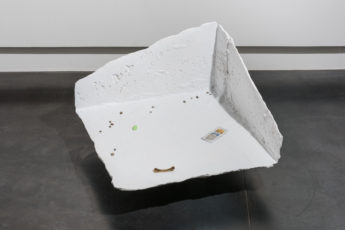
3am, mixed media, 2018
And that’s totally what I do now. 3AM was inspired by the littered entranceway of a Walgreens in Portland. There was a piece of gum and a mayonnaise packet and a small pile of chicken bones. Though it was gross, it had a formal beauty that made me look. I memorized it and recreated each thing. I knew I couldn’t sit at Walgreens for a week to make a mold of that spot. They wouldn’t be interested in that sort of weirdness. But there was an area in my Portland basement that looked similar.
Over here is an old gas can that I reworked called Manders. People bring me barely intact stuff from shooting ranges. The gas can was half-buried somewhere out in Mount Hood, Oregon. A friend found its top sticking out of the earth, dug it up, saw that it was used for target practice, and gave it to me a couple years ago. I cleaned it up and painted it silver.
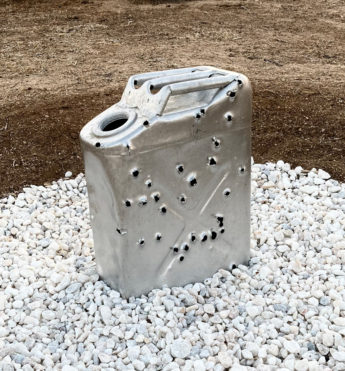
Manders, gas can, paint, 2016
This piece, Help Yourself, was a cardboard box that was in my backyard in 2006. I was doing construction on the house with a friend, and one of the boxes from a piece of equipment was left tossed in the yard. It sat outside in the rain for a year. I saw it all the time, but on one particular day, I was just completely taken by its shape, so I had it cast in aluminum.
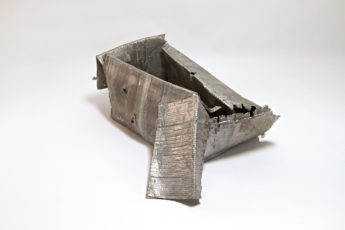
Help Yourself, aluminum, 2008
Next to it is a piece called Violence Makes Me Mobile. It’s a grocery cart that was shoved into somebody’s blackberry bush in Portland. I wrestled it out, and it was perfect. Someone had tried to pull the metal off of it for recycling, so it looked like it had been hit by a train. As with Manders, instead of recasting the object, I just painted it. Besides, its thinness makes it too challenging to cast.
This last piece is called Weakness. For this one, I learned how to build my own wood form for casting in concrete. I really loved the process, so that’s where I am now, I’m casting everything I can in concrete. Next time you visit, I’ll have finished a water feature I’m about to start. It will be a blue concrete casting of a crushed plastic kiddie pool I found off the side of the road. I’ll be placing my abstracted glass squirrel forms on the inside and the water will shoot out of each one.
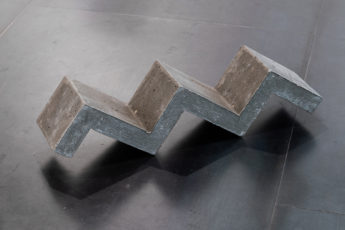
Weakness, concrete, 2019
Q: Tell me about this piece.
A: I found a dead housefly in my Portland house and cast it in 24K gold. I soldered a pin to its belly and inserted it into the wall. It’s called Extinction Anxiety. For this other piece on my work table, I took a twisted bottle from the streets of Scotland—I was there attending a glass symposium—and cast it in glass. So here again, I took a discarded throwaway with a particularly interesting shape, cleaned it up, made a mold, and cast it in a fragile material. Something completely opposite to what it used to be.
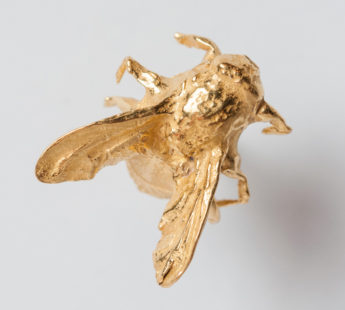
Extinction Anxiety, 24k
Q: With so many ideas, whether it’s about your vision for this place or your ideas about art, they take a long time to implement. Does that cause you a lot of anxiety?
A: I’ve always been sensitive to the fact that time is really quite finite, so I’ve always moved very fast. But now at 53, I’m on full speed. And I’m really inspired by this desert.
Those first few months here were really hard on me. I felt like a little baby. I didn’t even know how to ship FedEx here, because the system in this tiny town is very different from Portland’s. The learning curve has been steep. Not to mention the weather is like a 180-degree turn from the Pacific Northwest. The Santa Ana winds have been the most challenging part. I can totally handle the heat, but the relentless wind can drive you insane. Learning how to work with landscaping in this kind of environment has kicked my ass and ignited my practice.
For more information, please check out heidischwegler.com.
